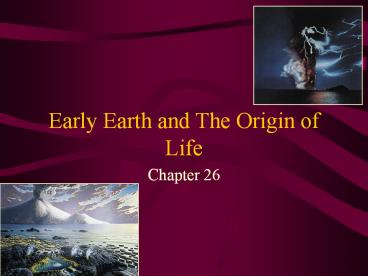Early Earth and The Origin of Life PowerPoint PPT Presentation
1 / 28
Title: Early Earth and The Origin of Life
1
Early Earth and The Origin of Life
- Chapter 26
2
(No Transcript)
3
Your book uses a clock analogy
4
The Earth cooled, then what happened?
3.9 billion years ago ? 1st life formed
1st fossils of life discovered? prokaryotes
5
Ancient Bacterium 1st prokaryotes
Fossilized bacterium 3.5 bya
Some bacteria of today
6
Two braches of the prokaryotic tree occurred
relatively early.
- A split 3 billion years ago
- Split into the bacteria and archea.
Fossilized bacteria found In stromatolites, mats
of bacteria
7
About 2.7 bya oxygen accumulated in the atmosphere
- 1st photosynthesizing bacteria that produced
oxygen ? CYANOBACTERIA
8
Evidence for Oxygen in early atmosphereBanded
iron formations
- O2 produced? dissolved in sea? precipitated as
iron oxide.
9
Large spike in O2 levels? Nearly 10 increase
2.2 bya? What happened?
- Evolution of 1st eukaryotic organisms were algae
that contained organelles called chloroplasts. - Killed many bacteria ? survivors are found today?
Obligate anearobes. - Other survivors became specialize and cell
respiration was born.
10
Origins of eukaryotic life 2.2 bya
11
Evolution of multicellular eukaryotes 1.2 bya
1st multiucellular eukaryotes? algae
12
Then an ice age! 750 570 mya
- Confined life to deep sea vents and areas where
glacier melt allowed sunlight through the surface
of the waters.? Called the SNOWBALL EARTH. - Then the thaw and the first major diversification
of eukaryotes evolved ? then the second
diversification in the early Cambrian produced
the major lineages we know today.
13
Then an explosion of animal life Cambrian period
about 543 mya
14
Plants, fungi then animals colonized the land 500
mya
Plants evolved adaptations to land Concurrently
with fungi that Obtain nutrients from the
plants? In return the plants get increased
water Absorption ?SYMBIOSIS
Then herbavores and their predators
15
Animal evolution
- Herbavores (plant eating) ? Predators
- Arthropods (invertebrates) ? Vertebrates
(amphibians ? land dwelling ? reptiles ? Birds
and mammals ? Humans)
16
The origins of life
- 4 bya ? Earths crust solidified ? No life
- 3.5 bya ? 1st Prokaryotes seen
- That means that somewhere between 4 bya to 3.5
bya life evolved.
17
What happened in that 500 million years?
- It was thought that life could arise from
nonliving matter ? Spontaneous generation - Louis Pasteurs experiments showed this not to be
true
18
Pasteurs Experiments
19
So biogenesis ? life only comes from life, made
its way into the scientific community.
- But it must have been violated at least once
right? - Most scientists see a 4 stage model for the
evolution of life.
20
Evolution of life 4 stage model
- Stage 1 Abiotic synthesis organic chemicals
combined to form the first molecules of biology
(amino acids and nucleotides) - Stage 2 The joining of these molecules to
produce more complex polymers (proteins and
nucleic acids) - Stage 3 The development of these molecules to
self -replicate. - Stage 4 The packaging of these molecules into
protobionts? droplets of membranes.
21
Evidence for stage 1 Abiotic synthesis organic
chemicals combined to form the first molecules of
biology (amino acids and nucleotides)
- Oparin-Haldane Hypothesis
- Conditions of early Earth were favorable for the
formation of organic compounds from inorganic
precursors. - Cannot replicate in todays world rich in O2
(from the evolution of plants) - What effect does O2 have on bond formation?
- Miller and Urey tested the hypothesis in the lab
22
Miller-Urey experiment
23
Conclusion of experiment
- Organic molecules such as amino acids and
nucleotides formed. - Just said it was possible to happen this way, not
that it did happen this way.
24
Other possibilities
- Deep Sea vents
- Meteorites may have contained some of the
essential materials.
25
Evidence for stage 2 The joining of these
molecules to produce more complex polymers
(proteins and nucleic acids)
- Heat vaporizes water in solutions that contain
these organic molecules ? result ? dehydration ?
polymerization of simple polypeptides. - Primitive earth had many heat sources for this to
occur? ex lava deep sea vents etc.
26
Stage 3 The development of these molecules to
self-replicate.
- Which came first, the chicken (enzyme) or the egg
(nucleic acid)? - Answer Both the chicken is part egg, that is RNA
has both information storage capabilites and
enzymatic activiy (ribozymes). - RNA can be autocatalytic.
27
(No Transcript)
28
Stage 4 The packaging of these molecules into
protobionts? droplets of membranes.
Natural Selection at the molecular level

